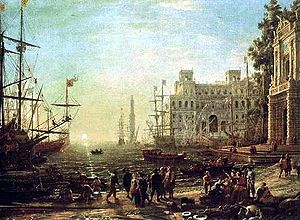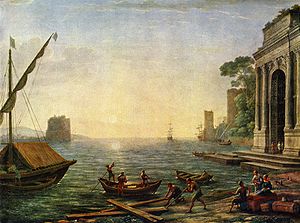- Claude Lorrain
-
Claude Lorrain, (French pronunciation: [klod lɔ.ʁɛ̃]), traditionally just Claude in English (also Claude Gellée, his real name, or in French Claude Gellée, (French pronunciation: [ʒəle]), dit le Lorrain) (c. 1600 – 21 or 23 November 1682) was an artist of the Baroque era who was active in Italy, and is admired for his achievements in landscape painting.
Contents
Biography
Early years
Claude was born in 1604 or 1605 into poverty in the town of Chamagne, Vosges in Lorraine – then the Duchy of Lorraine, an independent state until 1766 and now in northeast France. He was one of five children. His actual name was Claude Gellée, but he is better known by the province in which he was born. Orphaned by age of twelve, he went to live at Freiburg with an elder brother, Jean Gellée, a woodcarver. He afterwards went to Rome to seek a livelihood and then to Naples, where he apprenticed for two years, from 1619 to 1621, under Goffredo (Gottfried) Wals. He returned to Rome in April 1625 and was apprenticed to Agostino Tassi. He got into a fight with Leonaert Bramer.
He apparently was able to tour in Italy, France and Germany, including his native Lorraine, suffering numerous misadventures. Claude Deruet, painter to the duke of Lorraine, kept him as assistant for a year; and at Nancy he painted architectural subjects on the ceiling of the Carmelite church.
Mature works
In 1627 Claude returned to Rome. Here, two landscapes made for Cardinal Bentivoglio earned him the patronage of Pope Urban VIII. From about 1637 he rapidly achieved fame as a painter of landscapes and seascapes. He apparently befriended his fellow Frenchman Nicolas Poussin; together they would travel the Roman Campagna, sketching landscapes. Though both have been called landscape painters, in Poussin the landscape is a background to the figures; whereas for Claude, despite figures in one corner of the canvas, the true subjects are the land, the sea, and the air. By report, he often engaged other artists to paint the figures for him, including Courtois and Filippo Lauri. He remarked to those purchasing his pictures that he sold them the landscape; the figures were gratis.
In order to avoid repetition of subjects, and also to expose the many spurious copies of his works, he made tinted outline drawings (in six paper books prepared for this purpose) of all those pictures sent to different countries; and on the back of each drawing he wrote the name of the purchaser. These volumes he named the Liber Veritatis (Book of Truth). This valuable work, engraved and published, has always been highly esteemed by students of the art of landscape. Claude, who suffered much from gout, died in Rome on either 21 November or 23 November 1682, leaving his considerable wealth between his only surviving relatives, a nephew and an adopted daughter (possibly his niece). Originally buried in Santissima Trinità al Monte Pincio (commonly known as Trinità al Monte).
Critical assessment and legacy
In Rome, not until the mid-17th century were landscapes deemed fit for serious painting. Northern Europeans working there, such as Elsheimer and Brill, had made such views pre-eminent in some of their paintings (as well as Da Vinci in his private drawings [1] or Baldassarre Peruzzi in his decorative frescoes of vedute); but not until Annibale Carracci and his pupil Domenichino do we see landscape become the focus of a canvas by a major Italian artist. Even with the latter two, as with Claude, the stated themes of the paintings were mythic or religious. Landscape as a subject was distinctly unclassical and secular. The former quality was not consonant with Renaissance art, which boasted its rivalry with the work of the ancients. The second quality had less public patronage in Counter-Reformation Rome, which prized subjects worthy of "high painting," typically religious or mythic scenes. Pure landscape, like pure still-life or genre painting, reflected an aesthetic viewpoint regarded as lacking in moral seriousness. Rome, the theological and philosophical center of 17th century Italian art, was not quite ready for such a break with tradition.
In this matter of the importance of landscape, Claude was prescient. Living in a pre-Romantic era, he did not depict those uninhabited panoramas that were to be esteemed in later centuries, such as with Salvatore Rosa. He painted a pastoral world of fields and valleys not distant from castles and towns. If the ocean horizon is represented, it is from the setting of a busy port. Perhaps to feed the public need for paintings with noble themes, his pictures include demigods, heroes and saints, even though his abundant drawings and sketchbooks prove that he was more interested in scenography.
Claude was described as kind to his pupils and hard-working; keenly observant, but an unlettered man until his death. The painter Joachim von Sandrart is an authority for Claude's life (Academia Artis Pictoriae, 1683); Baldinucci, who obtained information from some of Claude's immediate survivors, relates various incidents to a different effect (Notizie dei professoni del disegno).
John Constable described Claude as "the most perfect landscape painter the world ever saw", and declared that in Claude’s landscape "all is lovely – all amiable – all is amenity and repose; the calm sunshine of the heart".[1]
Selected works
- Landscape with Merchants (The Shipwreck) (1630) - National Gallery of Art, Washington, D.C.
- Landscape with Goatherd (1636) - National Gallery, London
- The Ford (1636) - Metropolitan Museum, NY
- Port with Villa Medici (1637) - Galleria degli Uffizi, Florence
- Finding of Moses (1638) - Oil on canvas, 209 x 138 cm, Museo del Prado, Madrid
- Pastoral Landscape, (1638) Minneapolis Institute of Arts
- Seaport (1639) - National Gallery, London
- Seaport at Sunset (Odysseus) (1639) - Oil on canvas, 119 x 150 cm, Musée du Louvre, Paris
- View of Campagna (c. 1639) - Oil on canvas, 101.6 x 135.9 cm, Royal Collections
- Embarkation of Saint Paula Romana at Ostia (1639) - Oil on canvas, 211 x 145 cm, Museo del Prado, Madrid
- The Embarkation of St. Ursula (1641) - National Gallery, London
- The Disembarkation of Cleopatra at Tarsus (1642) - oil on canvas, Musée du Louvre, Paris.
- The Disembarkation of Cleopatra at Tarsus (1642–43) - Oil on canvas, 119 x 170 cm, Musée du Louvre, Paris
- The Trojan Women Setting Fire to their Fleet - Metropolitan Museum, NY
- Brook and Two Bridges - Oil on canvas, 74 x 58 cm,
- Voyage of Jacob
- The Angel's Visit
- View of the Church Santa Trinità Dei Monti - drawing, Hermitage, St. Petersburg
- Seaport with Castle - Howard University Gallery of Art, Washington D.C.
- View of Tivoli at Sunset (1644) - San Francisco Museum of Art
- Mercury Stealing Apollo's Oxen (1645) - Oil on canvas, 55 x 45 cm, Galleria Doria-Pamphilj, Rome
- Landscape with Cephalus and Procris reunited by Diana (1645) - Oil on canvas, 102 x 132 cm, National Gallery, London
- The Judgement of Paris (1645–46) - National Gallery of Art at Washington D.C.
- Sunrise (1646–47) - Metropolitan Museum, New York
- Embarkation of the Queen of Sheba (1648) - National Gallery, London
- Marriage of Isaac and Rebekah (1648) - National Gallery, London
- Landscape with Paris and Oenone (1648) - Oil on canvas, 119 x 150 cm, Musée du Louvre, Paris
- Landscape with Dancing Figures (The Mill) (1648) - Oil on canvas, 150,6 x 197,8 cm, Galleria Doria-Pamphili, Rome
- View of La Crescenza (1648–50) - Oil on canvas, 38.7 x 58.1 cm, Metropolitan Museum of Art, New York
- The Rest on the Flight into Egypt (1651 or 1661) - Oil on canvas, 113 x 157 cm, The Hermitage, St. Petersburg
- Landscape with Mercury and Battus (1654) - Oil on canvas, 74 x 98 cm, Swiss private collection
- Landscape with Hagar and the Angel (1654) - Oil on canvas, 54.5 x 76 cm, Dunedin Public Art Gallery, Dunedin.
- Landscape with Acis and Galatea (1657) - Oil on canvas, 100 x 135 cm, Gemäldegalerie, Dresden
- Landscape with Apollo and Mercury (1660) - Oil on canvas, 74,5 x 110,5 cm, Wallace Collection, London
- Landscape with a dance (The Marriage of Isaac and Rebeccah (1663) - Drawing[2]
- Coast Scene with the Rape of Europa (1667) - Oil on canvas, 134,6 x 101,6 cm, Royal Collection, London
- The Expulsion of Hagar (1668) - Oil on canvas, 107 x 140 cm, Alte Pinakothek, Munich
- Seaport (1674) - Oil on canvas, 72 x 96 cm, Alte Pinakothek, Munich
- Ascanius Shooting the Stag of Sylvia (1682) - Ashmolean Museum, Oxford.
- View of a Seaport - The Huntington Library, San Marino, CA
See also
Further reading
- DULLEA, Owen J., Claude Gellée de Lorrain, New York, Scribner and Wellford, 1887.
- CHIARINI, Marco. CLAUDE LORRAIN - Selected Drawings. Pennsylvania State University Press, 1968.
- Michael Kitson, Claude Lorrain, Liber veritatis (British Museum Publications, London, 1978) ISBN 0-7141-0748-4
- RUSSEL, H. Diane, Claude Lorrain, 1600–1682, New York, George Braziller, 1982.
- LAGERLÖF, Margaretha Rossholm, Ideal Landscape: Annibale Carracci, Nicolas Poussin and Claude Lorrain, New Haven, Yale University Press, 1990.
External links
- Claude's Biography, Context and Artworks
- National Gallery
- www.ClaudeLorrain.org 149 works by Claude Lorrain
- Web Gallery of Art
 "Claude de Lorrain". Catholic Encyclopedia. New York: Robert Appleton Company. 1913.
"Claude de Lorrain". Catholic Encyclopedia. New York: Robert Appleton Company. 1913.- Sterling and Francine Clark Art Institute 2007 exhibition, Claude Lorrain: The Painter as Draftsman
References
 This article incorporates text from a publication now in the public domain: Chisholm, Hugh, ed (1911). Encyclopædia Britannica (11th ed.). Cambridge University Press.
This article incorporates text from a publication now in the public domain: Chisholm, Hugh, ed (1911). Encyclopædia Britannica (11th ed.). Cambridge University Press.
Categories:- French painters
- Landscape artists
- 1600s births
- 1682 deaths
- People from Vosges
Wikimedia Foundation. 2010.





